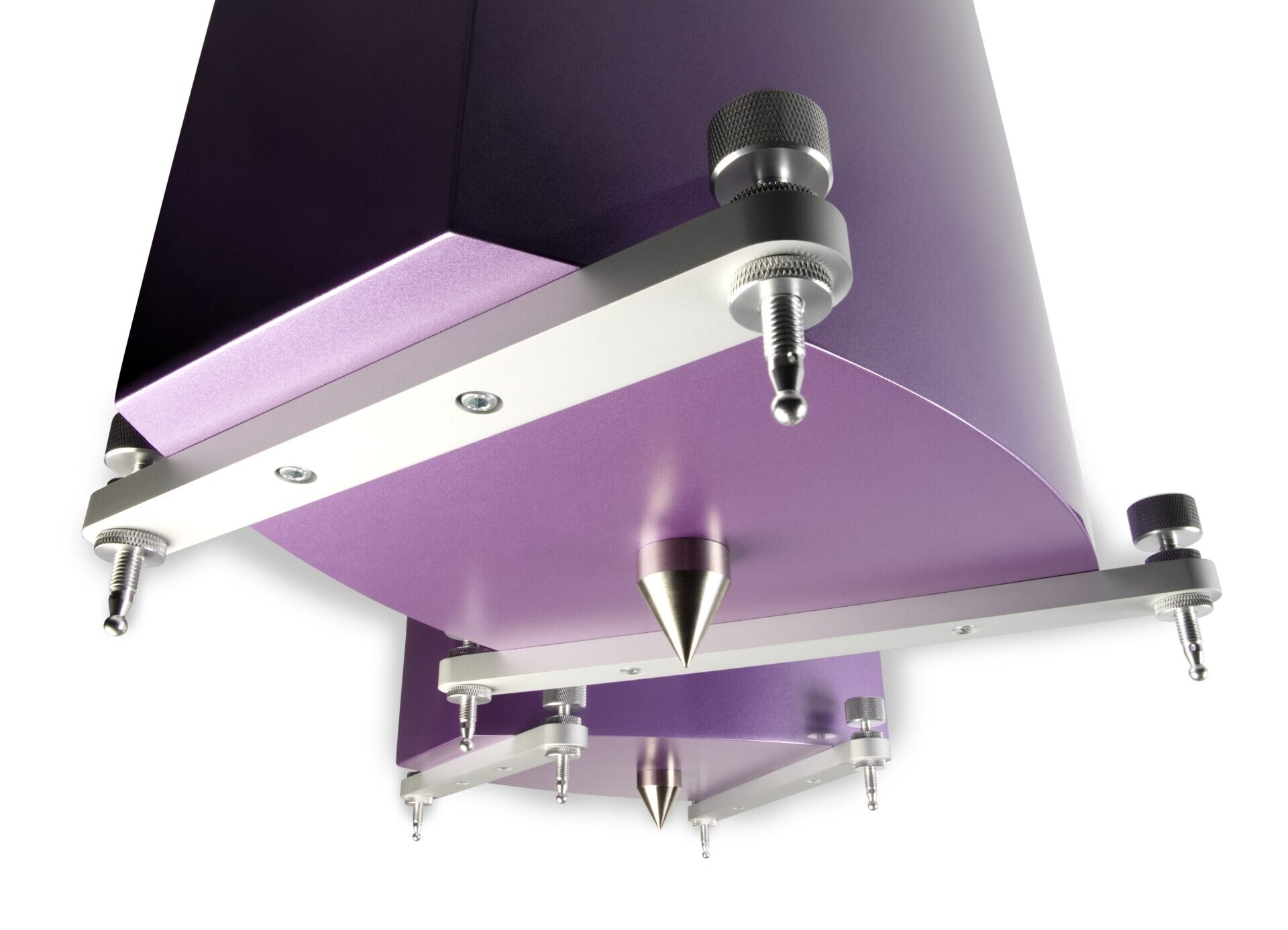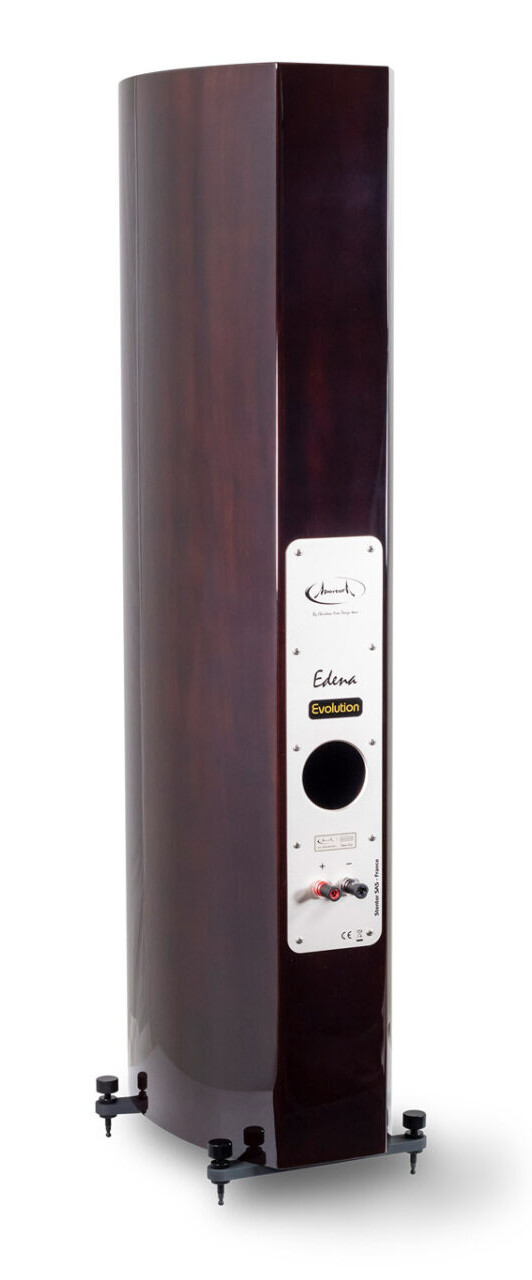
The enclosure is reflex-loaded by a large, rear-facing port and is single-wired via a pair of high-quality binding posts. Apertura claims a -3dB point at 35Hz with system sensitivity that’s realistically quoted as 89dB. The cabinet is available in a range of four wood veneers (or optional car paint finishes at extra cost) and stands on a set of the increasingly common out-rigger feet. What isn’t immediately self-evident is that the cabinet rests on a substantial aluminium cone, positioned immediately below its centre of gravity, the four adjusters on the outriggers having rounded tips and serving as stabilisers.
Compare the physical description, parts quality and thinking that’s gone into the Edena Evolution and the similarities with the Kalya are striking. But the best bit is the price. At €10,000 the Kalya looks expensive for a two-way stand-mount, whereas at €7,890, the Edena looks (and sounds) like an awful lot of speaker for the money! Drive it properly, and its musical fluency, its versatility and its engaging character might well surprise you, not least because the speaker’s musical strengths are in precisely those areas where – outwardly at least – you might expect it to be weakest.
Speaking with a single voice…
 For a speaker with so many distinctly different aspects to its design and construction, not least its hybrid topology, this is an astonishingly coherent musical performer. Listening to the Edena Evolution, the first thing that should strike you is the extent and transparency of the soundstage. The sound stands away from the speakers, the enclosures and drivers disappearing, both as musical sources and mechanical influences. You don’t hear (or at least, you don’t notice) these speakers working, which is a telling fact considering their nature. Most transducers leave their greasy fingerprints all over the signal, and when it comes to speakers, the culprits are legion, from driver coloration to cabinets that sing along, crossovers that are anything but invisible to dispersion discontinuities between drivers. With a relatively modest budget to spend on cabinetry (at least, one that excludes exotic materials) and drivers that operate in very different ways, the Apertura applies self-imposed challenges, yet its performance appears blissfully unaware of the potential handicap, living, breathing proof of the dangers of judging any book by its cover.
For a speaker with so many distinctly different aspects to its design and construction, not least its hybrid topology, this is an astonishingly coherent musical performer. Listening to the Edena Evolution, the first thing that should strike you is the extent and transparency of the soundstage. The sound stands away from the speakers, the enclosures and drivers disappearing, both as musical sources and mechanical influences. You don’t hear (or at least, you don’t notice) these speakers working, which is a telling fact considering their nature. Most transducers leave their greasy fingerprints all over the signal, and when it comes to speakers, the culprits are legion, from driver coloration to cabinets that sing along, crossovers that are anything but invisible to dispersion discontinuities between drivers. With a relatively modest budget to spend on cabinetry (at least, one that excludes exotic materials) and drivers that operate in very different ways, the Apertura applies self-imposed challenges, yet its performance appears blissfully unaware of the potential handicap, living, breathing proof of the dangers of judging any book by its cover.
Listening to the Passacaglia from the Shostakovich Violin Concerto No.1 (Batiashvili/Salonen/SODBR – DGG 0289 477 9299 4) the air above and around the orchestra is a single, vast volume, beyond and separate from the speakers. There are better recordings of this concerto, but it is an excellent performance. The Edena presents the album with an uncluttered stability and a real sense of musical purpose. The timp rolls are suitably portentous, the muted brass fanfares and orchestral development accurately measured, creating just the air of anticipation required to presage the violin’s entry. Given the general murkiness of the recording, that’s no mean feat, not just separating the various orchestral voices but maintaining their roles and relationships. It speaks volumes about the Edena’s phase and temporal coherence, its ability to preserve the patterns within the music. But that’s only the hors d’oeuvre. Once the violin starts playing, you are left in no doubt that what’s been captured on the disc is genuinely remarkable. First, supported with subtle string underpinnings, the solo instrument soon soars away, progressively stepped phrases extending the pitch, expressive range and emotional intensity of the music. In doing so of course, it doesn’t just walk the musical tightrope of Shostakovich’s devilishly difficult writing, but continually crosses the divide between the two drivers. Despite that, there is no discontinuity in texture or projection, no awkward junction between fundamentals and harmonics, no slurring or slippage in the placement or tails of the notes, even though as the piece progresses the instrument works higher and higher up its range.

